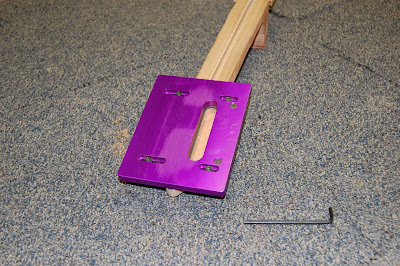






 So, turns out FireFox and Blogger don't get along too well, so again we have a pile of pictures, and a separate pile of thoughts that vaguely seem to correspond with that pile. Good luck!
So, turns out FireFox and Blogger don't get along too well, so again we have a pile of pictures, and a separate pile of thoughts that vaguely seem to correspond with that pile. Good luck!This week at guitar camp, we have been finishing up all of the final steps leading up to, well... finishing.
I've been ahead of the pack for most of the way building this classical guitar. Every time I start to get too far ahead, they make me wait for the other guys to catch up. So forgive me if it doesn't look like I got much done this week. Last Friday I had prepared all of my frets for the fingerboard, which involves cutting cutting the frets oversize and then trimming the fret tang until it is about .050" narrower than the distance between the fingerboard bindings. This allows the tang to be hidden behind the binding. The fret bead however remains long and after the frets have been glued and hammered in, you must cut back the excess bead of the frets.
The end nippers you can see here are used to cut back the majority of the excess fret bead, I then use a flat mill file to bring the the fret ends flush to the fretboard edge. The file we use here actually has a handle glued to the back of it, and allows you to easily hold it while running the file parallel with the neck and hitting lots of fret ends all at once. This makes for fast work.
This block here is a little something we like to call the 33 degree bevel block, but I never have figured out why we call it that. Anyways, we use it for filing the fret ends to a comfortable angel, right about 33 degrees. It leaves a rather rough edge but after the frets have been leveled, recrowned and polished, we come back with a small sanding block and polish the fret ends to a crisp profile.
As I mentioned before, the frets are installed with super glue on the tang so that the fret is not relying only on the tang barbs to keep its grip in the fret slot. Mastering the feat of applying the perfect amount of glue to the tang so that the fret will hold securely, but not so much as to make a perfect mess is something that takes more than a few attempts. You should have a little glue squeeze out though, if nothing more than to let you know you accomplished the first half of the feat. After all of the frets have been hammered in, you may suddenly find yourself relieved to remember that you did in fact not forget to first WAX the fretboard as I did not mention above. It is now time to chisel the excess dried glue from the edges of each fret, and if you did not find yourself suddenly relieved by this point, this is not going to be a pretty job. The less glue squeeze-out you have, the better, since bigger blobs of glue tend to cling to the fretboard a bit more.
I am getting a lot better at my fret work, making sure that the crown is restored after leveling, and bringing every surface back to a brilliant shine. I don't have any great pictures of that part right now, but maybe after the guitar is finished I'll show some of my fret work shots. Well now I guess that is the biggest bit of "work" I did this week. Now all I have left is pictures of how I'm leaving the guitar for the weekend. My guitar is all sanded and ready for finishing, so in theory, we will start spraying finish on Monday. But the class ahead of me is spraying arch tops right now and we will have to fight for space in the spray room with them.
I have a picture of the headstock here which you may have noticed is a good deal different than the headstock of my baritone. The ridge at the base of it, called the volute is much straighter on this guitar. This is probably the hardest spot to sand on the guitar since you must be so careful not to distort the crisp lines you have created. Any sanding scratches will be highlighted with the grain filler, so it's best to remove them now. Once you have reached 320 grit, the scratches made are no longer deep enough to be an issue.
Here is a picture of how the neck of the guitar will sit on the face of the guitar. Or how it doesn't, rather. This is called a cantilever neck and should not touch the face of the guitar at all. The neck should only be fit to the body from the very peak of the sides on down to the heal cap. This may have a couple benefits, being mainly that the guitar top is left to resonate more freely without a fretboard being glued to it, and also, it makes for much easier neck sets as you are only working with one plane to be fitted, rather than two. Here's a better shot of my neck/body joint. This is the first neck set and fit that I've done here at school, and while it will need a final touch-up after the finish is completed, I'm pretty happy with it so far. It was not too stressful, and turned out looking pretty sharp, while actually achieving the proper neck pitch.
Thanks for checking in.
Brian

















